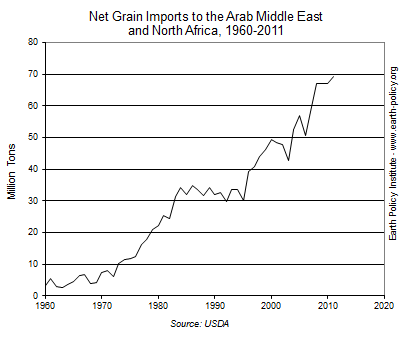The Arab countries in the Middle East and North Africa make up only 5 percent of the world’s population, yet they take in more than 20 percent of the world’s grain exports. Imports to the region have jumped from 30 million tons of grain in 1990 to nearly 70 million tons in 2011. Now imported grain accounts for nearly 60 percent of regional grain consumption. With water scarce, arable land limited, and production stagnating, grain imports are likely to continue rising.
Egypt is the largest grain producer in the Arab world, accounting for almost 40 percent of the region’s harvest. Its grain production has doubled over the last 20 years. But because nearly all of the country’s available freshwater and arable land is already used for agriculture, further expansion of the grain harvest is unlikely.
In the 1980s, Saudi Arabia began pumping fossil water from deep underground, allowing it to farm the desert. By subsidizing wheat production at several times the world price, Saudi Arabia became the second largest Arab wheat producer in the early 1990s. At its peak, Saudi Arabia harvested more than twice the wheat it consumed, exporting the excess. But with the underground water supplies nearly depleted, wheat production has plummeted. By 2016, Saudi Arabia plans to phase out wheat production entirely. In a span of 25 years, the country will have gone from exporting wheat to relying exclusively on imports. More
